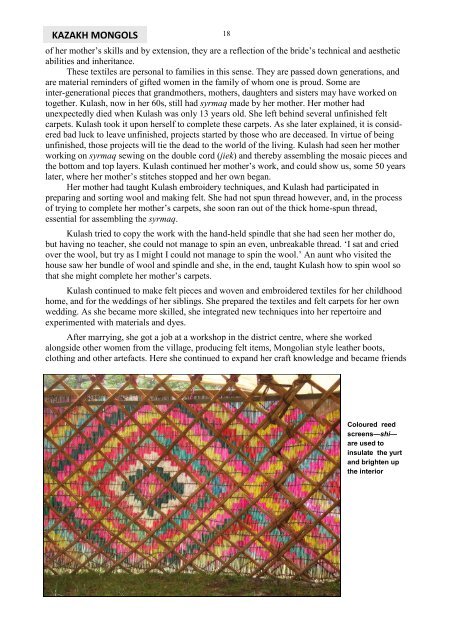ASIAN TEXTILES - OATG. Oxford Asian Textile Group
ASIAN TEXTILES - OATG. Oxford Asian Textile Group
ASIAN TEXTILES - OATG. Oxford Asian Textile Group
You also want an ePaper? Increase the reach of your titles
YUMPU automatically turns print PDFs into web optimized ePapers that Google loves.
KAZAKH MONGOLS18of her mother’s skills and by extension, they are a reflection of the bride’s technical and aestheticabilities and inheritance.These textiles are personal to families in this sense. They are passed down generations, andare material reminders of gifted women in the family of whom one is proud. Some areinter-generational pieces that grandmothers, mothers, daughters and sisters may have worked ontogether. Kulash, now in her 60s, still had syrmaq made by her mother. Her mother hadunexpectedly died when Kulash was only 13 years old. She left behind several unfinished feltcarpets. Kulash took it upon herself to complete these carpets. As she later explained, it is consideredbad luck to leave unfinished, projects started by those who are deceased. In virtue of beingunfinished, those projects will tie the dead to the world of the living. Kulash had seen her motherworking on syrmaq sewing on the double cord (jiek) and thereby assembling the mosaic pieces andthe bottom and top layers. Kulash continued her mother’s work, and could show us, some 50 yearslater, where her mother’s stitches stopped and her own began.Her mother had taught Kulash embroidery techniques, and Kulash had participated inpreparing and sorting wool and making felt. She had not spun thread however, and, in the processof trying to complete her mother’s carpets, she soon ran out of the thick home-spun thread,essential for assembling the syrmaq.Kulash tried to copy the work with the hand-held spindle that she had seen her mother do,but having no teacher, she could not manage to spin an even, unbreakable thread. ‘I sat and criedover the wool, but try as I might I could not manage to spin the wool.’ An aunt who visited thehouse saw her bundle of wool and spindle and she, in the end, taught Kulash how to spin wool sothat she might complete her mother’s carpets.Kulash continued to make felt pieces and woven and embroidered textiles for her childhoodhome, and for the weddings of her siblings. She prepared the textiles and felt carpets for her ownwedding. As she became more skilled, she integrated new techniques into her repertoire andexperimented with materials and dyes.After marrying, she got a job at a workshop in the district centre, where she workedalongside other women from the village, producing felt items, Mongolian style leather boots,clothing and other artefacts. Here she continued to expand her craft knowledge and became friendsColoured reedscreens—shi—are used toinsulate the yurtand brighten upthe interior
















